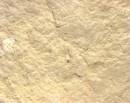| Back | Main Details | Samples & Images | Quarries | Usage | References |
| Local Name(s): |
Clunch Stone, Totternhoe Stone. |

|
|||||
|---|---|---|---|---|---|---|---|
| Stone Group: | Sedimentary | ||||||
| Stone Type: | Limestone | ||||||
| Geology: |
|
||||||
| Geological Sub-Divisons: | Chalk Group, Lower Chalk Formation. |
||||||
| General Colour Description: | Greyish white often with a greenish tinge (due to the glauconite) and occasionally brownish grey. It can be almost white when freshly broken. |
||||||
| Hand Specimen Description: | A compact, soft, fine grained, fossiliferous limestone which is relatively well sorted. It can be phosphatic in part with dark brown pellets a few mm across, up to nodules several cm across. |
||||||
| Petrographic Description: | It consists largely of minute fragments of shells such as the fossil bivalve (inoceramus and entolium orbiculare), brachiopods, worm burrows, fish remains and the ammonite (papapuzosia). Ooccasional tiny quartz grains, glauconite (phosphatic, dark brown pellets) and brown iron ore are also present set in a calcareous matrix comprising minute polygonal cylinders of calcite. |
||||||
| General Comments: | It is known as Totternhoe stone in Bedfordshire, or Burwell Rock or 'clunch' in Cambridgeshire. |
||||||
| Stone Identifiers: | Chalk, Calcareous, Fossiliferous. | ||||||
| Reacts dilute to HCl? | Yes | ||||||